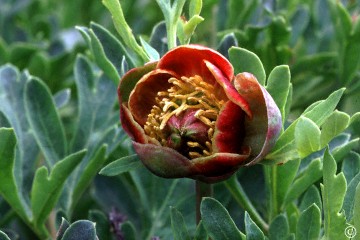
Home | Next | Previous | Index | Purchase book
Idaho Mountain Wildflower
The Peony Family, Paeoniaceae
The peony family is a small one, consisting of only one genus and 33 species. Typically white-petaled, most are perennial shrubs or small trees whose alternate leaves are divided into three lobes, each lobe, in turn, divides into three or more smaller lobes. The flowers are usually large, radially symmetrical, with five sepals, five petals (occasionally ten), and many stamens. Five large seed capsules form while the plant is still flowering, each contains many seeds. The family’s chief commercial value is for its cultivars—well known ornamental garden varieties with showy blossoms. Peonies were named by Theophrastus (372-c.287 B.C.), Aristotle’s pupil and the author of an important work on botany. The name honors Apollo who, in his role as Paean, physician to the gods, used the plant medicinally. Only two peonies are native to North America. The similar California peony, Paeonia californica, growsonly there.
 |
Western peony, Paeonia
brownii Douglas ex Hook.
One might not relate the western peony’s flowers
to those of the popular garden plant, nevertheless, they are close cousins.
Our plants grow as high as the subalpine zone and are often seen along hiking
trails, in canyon bottoms and on nearby sagebrush slopes, blooming in mid-
to late spring. The large flowers nod and may be hard to see at first glance,
although the plant’s light green, deeply incised leaves stand out
conspicuously against the surrounding sagebrush. The flower is so unusual
that it is easily identified. David Douglas had collected the plant in the
mountains of today’s Oregon in 1826. Douglas suggested that it be named
for Robert Brown (1773-1858) a prominent English botanist. William Jackson
Hooker described it several years later in his Flora Boreali-Americana
(1829) and followed Douglas’s suggestion in naming the plant.
|
Home | Next | Previous | Index | Purchase book